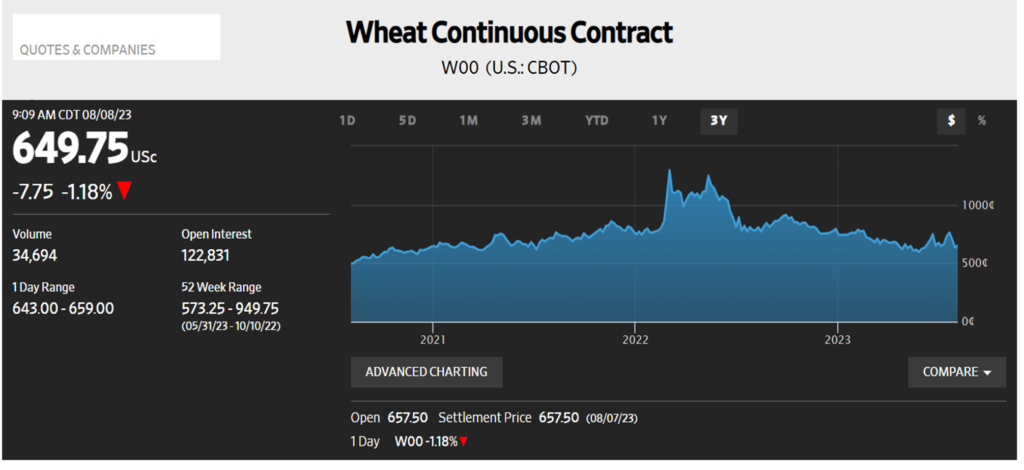Ukraine’s contribution to global grain flows will be reduced. Russia’s July 17 withdrawal from the Black Sea Grain Initiative and military action against agricultural and port infrastructure will slash this year’s production potential and shipping capacity (here and here and here). According to the USDA:
Ukraine planted area is down significantly as a result of the war with Russia. Production in 2023/24 is forecast at 17.5 million tons, the smallest crop in over a decade. With sharply reduced supplies and uncertainty surrounding the future of the Black Sea Grain Initiative (BSGI), 2023/24 Ukraine wheat exports are forecast lower at 10.5 million tons, down over 40 percent from the pre-war average (2016/17-2020/21). While the BSGI helped Ukraine export 16.8 million tons of wheat in 2022/23, 39 percent of wheat moved outside of the grain corridor (primarily via land shipments to Eastern Europe).
The loss of a significant portion of Ukraine’s prior production comes in the midst of other production constraints. According to the USDA July Grain Report: “Global production is forecast down with smaller crops in Argentina, Canada, and the European Union… Global consumption is forecast higher, mostly on larger feed and residual use in China. Global stocks are forecast down, mostly on reductions for China and Russia, reaching the lowest level since 2015/16.” (More)
Global grain prices have not, however, seen significant increases so far (see chart below). This reflects strong results and/or projections for big parts of grain production in the United States (more), Russia, Pakistan, and some others. In the southern hemisphere, Brazil and Australia had very strong 2022-2023 harvests.
Always uncertain and increasingly extreme weather could still be disruptive, but where there is an ability to pay there is typically plenty of food supply to be had. According to the United Nations Food and Agricultural Organization, “The FAO Food Price Index (FFPI) averaged 123.9 points in July 2023, up 1.5 points (1.3 percent) from June but remaining 16.6 points (11.8 percent) below its value in the corresponding month last year. The FFPI’s rebound in July was led by a solid rise in the vegetable oils price index, partially offset by a significant decline in the sugar price index, together with small decreases in the price indices for cereals, dairy and meat.” (More)

+++
August 10 Update: Bloomberg reports:
A surge in rice prices to the highest level in almost 15 years is renewing fears that food costs are going to get a lot more expensive for the world’s poorest people. The grain is vital to the diets of billions in Asia and Africa. Rice contributes as much as 60% of total calorie intake for people in parts of Southeast Asia and Africa, and that rises to 70% in countries like Bangladesh. The latest price jump increases stress on global food markets already roiled by extreme weather and the escalating conflict in Ukraine. Thai white rice 5% broken, an Asian benchmark, climbed to $648 a ton this week as dry weather threatens Thailand’s crop, and after top shipper India — which accounts for 40% of the world’s trade — ramped up export curbs to protect its local market.
August 12 Update: The new World Agricultural Supply and Demand Estimates (WASDE) were released on Friday. According to USDA, “The global wheat outlook for 2023/24 is for reduced supplies, lower consumption, decreased trade, and lower stocks. Supplies are projected to decline 4.3 million tons to 1,061.7 million…” S&P Global highlights, “The US Department of Agriculture has revised the corn yield estimate for marketing year 2023-24 (September-August) to 175.1 bushels/acre from 177.5 bu/acre…” Changes in production estimates for several non-US producers are also highlighted, including a bit better for Ukraine and a bit worse for China.